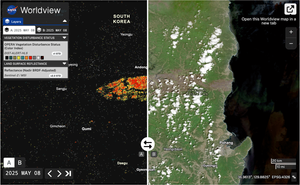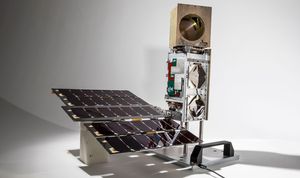Feature Articles

Introduction Landsat, a joint program of NASA and the U.S. Geological Survey (USGS), has been an invaluable tool for monitoring changes in Earth’s land surface for over 50 years. Researchers use instruments on Landsat satellites to monitor decades-long trends, including…

Introduction The NASA Soil Moisture Active Passive (SMAP) mission, launched in 2015, has over 10 years of global L-band radiometry observations. The low frequency [1.4 GHz frequency or 21 cm (8 in) wavelength] measurements provide information on the state of…

When woven together, the tapestry of experiences of staff and scientists provide the complete picture of OCO-2. Breathe in… Breathe out. This simple rhythm sets the foundation of life on Earth – and it’s a pattern that a NASA satellite…

Introduction Tropical cyclones represent a danger to life, property, and the economies of communities. Researchers who study tropical cyclones have focused on remote observations using space-based platforms to image these storms, inform forecasts, better predict landfall, and improve understanding of…

Introduction Since 1987, a highly modified McDonnell Douglas DC-8 aircraft has been a workhorse in NASA’s Airborne Science Program (ASP) – see Photo 1. The aircraft, located at NASA’s Armstrong Flight Research Center (AFRC) in California, flew countless missions as a…

Introduction The American Geophysical Union (AGU) returned to the nation’s capital in 2024, hosting its annual meeting at the Walter E. Washington Convention Center in Washington, DC from December 9–14, 2024. NASA Science upheld its long-standing tradition as an AGU…

Introduction Along the southernmost rim of the Florida Peninsula, the arching prop roots or “knees” of red mangroves (Rhizophora mangle) line the coast – see Photo 1. Where they dip below the water’s surface, fish lay their eggs, enjoying the protection…

Introduction On February 27, 2014, the four-ton Global Precipitation Measurement (GPM) Core Observatory (CO) spacecraft launched aboard a Japanese H-IIA rocket from Tanegashima Space Center in southern Japan. On that day, the GPM mission, a joint Earth-observing mission between NASA…

Introduction Organized by the Science Mission Directorate’s Science Support Office (SSO), NASA hosted its 12th annual Earth Day Celebration event from April 18–19, 2024. For the first time ever, the two-day event was held at NASA Headquarters (HQ) in Washington,…

Introduction In the 1990s and early 2000s, an international team of engineers and scientists designed an integrated observatory for atmospheric composition – a bold endeavor to provide unprecedented detail that was essential to understanding how Earth’s ozone (O3) layer and…

























